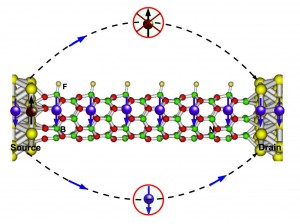
Fluorinated boron nitride nanotube as an ideal spin filter
Advisor: Dr. Ranjit Pati
Understanding the electronic structure and the transport property of nano scale materials is of fundamental importance, since these materials are the ultimate candidates for the future of nano technology. Several nano materials, such as quantum dots, semiconducting nano-wires, and organic molecules, have been explored both theoretically and experimentally as the components of electronic circuitry over the last two decades. Among several interesting nano materials, metal free magnetic nano materials are found to be very enticing due to the presence of magnetism in the absence of magnetic ions. Traditionally, the magnetism comes from partially occupied d and f states in the materials; however, this understanding is not always true since s and p states are found to contribute to the magnetism in the metal free magnetic materials. The main advantage of these materials is their high Curie temperature; as a result, they can be utilized in room temperature spin-electronics (spintronics). Recently, using a first-principles approach, we have demonstrated that the fluorinated boron nitride nanotube (BNNT), which is a metal-free magnetic entity, can be used as an excellent spin filter. All majority spin carriers are almost completely blocked while passing through the fluorinated BNNT channel, allowing only the minority spin carriers to pass. We have shown that the long range ferromagnetic spin ordering in fluorinated BNNTs occurs at a temperature much above room temperature.
For more information, please visit my webpage: http://www.phy.mtu.edu/~kbdhunga
By Kamal B. Dhungana
Reference:
Kamal B. Dhungana, Ranjit Pati, Fluorinated Boron Nitride Nanotube Quantum Dots: A Spin Filter. J. Am. Chem. Soc., 2014, 136, 11494–11498.